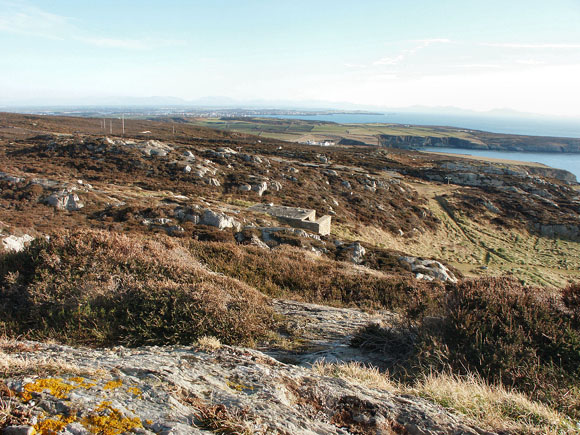Although it is the largest town in the county, with a population of 11,237 (2001 census), it is neither the county town nor actually on the isle of Anglesey but is instead located on Holy Island which is connected to Anglesey by Four Mile Bridge, so called because it is four miles (6 km) from Holyhead on the old post road from London, and a causeway (known locally as "the cob") built by local philanthropist Lord Stanley in the nineteenth century, which now carries the A5/A55 road and the railway line to Chester, Crewe and London.
The town's centre is built around St. Cybi's church, which is built inside one of Europe's only three-walled Roman forts (the fourth wall being the sea, which used to come up to the fort). The Romans also built a lighthouse on the top of Holyhead Mountain inside Mynydd y Twr, a prehistoric fortress. Settlements in the area date from prehistoric times, with circular huts, burial chambers and standing stones featuring in the highest concentration in Britain.
Holyhead is perhaps best known for its busy ferry port and freight harbour. Stena Line, Europe's biggest ferry company, operates from the port. Irish Ferries also operate from Holyhead. Ferries sail to Dublin and D�n Laoghaire in Ireland and this forms the principal link for surface transport from central and northern England and Wales to Ireland. There is archaeological evidence that people have been sailing between Holyhead and Ireland for 4000 years. The post road built by Thomas Telford from London strengthened Holyhead's position as the port, from where the royal mail was dispatched to and from Dublin. The A5 terminates at Admiralty Arch (1821, designed by Thomas Harrison to commemorate a visit by King George IV en route to Ireland) and marking the zeneth of Irish Mail coach operations. However, with the opening of the railway from London to Liverpool, Holyhead lost the London to Dublin Mail contract in 1839 to the Port of Liverpool. Only after the completion of the Chester and Holyhead Railway in 1850 and the building of Holyhead railway station did the Irish Mail return to Holyhead.
Holyhead (Welsh: Caergybi, "the fort of St. Cybi") is the largest town in the county of Anglesey in the northwest of Wales.
Holyhead's maritime importance was at its paramount in the 19th century when the two and a half mile (4 km) breakwater, widely acknowledged to be one of Britain's finest, was built, creating a safe harbour for vessels caught in stormy waters on their way to Liverpool and the industrial ports of Lancashire. Holyhead's sea heritage is remembered in a maritime museum.
Today, Holyhead's main industry is aluminium-based, with Rio Tinto Group's Anglesey Aluminium subsidiary operating a massive aluminium smelter on the outskirts of the town. There is also a plant that refines bauxite near the site. A large jetty in the harbour receives ships from Jamaica and Australia, and their cargo of bauxite and aluminium ores are transported on a conveyor belt that runs underneath the town to the plants.
Holyhead's arts centre, the Ucheldre Centre, is located in the chapel of an old convent belonging to the order of the Bon Sauveur.
Holyhead hosted the National Eisteddfod in 1927.
 Cinemas: Cinemas:
 Empire Empire
Stanley Street
Holyhead
Gwynedd
LL65 1HL
http://www.southwalescinemas.co.uk/
 Trains: Holyhead is on the North Wales Coast Line Trains: Holyhead is on the North Wales Coast Line
 Libraries: Libraries:
 Holyhead Library Holyhead Library
Newry Fields
Holyhead
LL65 1LA
01407 762917
Mon 10:00-17:00
Tue 10:00-19:00
Wed 10:00-13:00
Thur 10:00-19:00
Fri 10:00-19:00
Sat 09:30-12:30
 Vets: Vets:
 Bodrwnsiwn Veterinary Group Bodrwnsiwn Veterinary Group
The Veterinary Surgery
Kingsland Rd
Holyhead
Gwynedd
LL65 2SP
01407 769183
 Anglesey Pet Clinic Anglesey Pet Clinic
Cyttir Road
Kingsland
Holyhead
Gwynedd
LL65 2SY
01407 764999
 Youth Hostel: Anglesey Outdoors Youth Hostel: Anglesey Outdoors |






